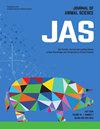159 Effects of artificial shade and chromium supplementation during mid and late gestation of beef cows under heat stress: cow performance and thermotolerance
IF 2.7
2区 农林科学
Q1 AGRICULTURE, DAIRY & ANIMAL SCIENCE
引用次数: 0
Abstract
The objective of the study was to evaluate the effects of the provision of artificial shade and chromium (Cr) supplementation during mid and late gestation on the performance and thermotolerance of beef cows. At 150 ± 20 d days prepartum (day 0), 72 fall-caving Angus-cross cows were stratified by body weight (BW; 566 ± 5.38 kg) and body condition score (BCS; 6.3 ± 0.5) and allocated into 1 to 12 bermudagrass pastures (3 to 5 ha pastures/5 or 7 cows per pasture). Treatments were randomly assigned to pastures in a 2 × 2 factorial: shade and Cr (SC), no shade and Cr (NSC), shade and no Cr (SNC) and no shade and no Cr (NSNC), applied from day 0 to 150 days before calving. Shade was provided by artificial structures made from black polypropylene fabric, with 4.2 m² of shaded area per animal/pasture. Chromium (Cr propionate; KemTRACE Chromium 0.4%, Kemin Industries) was added to a free choice mineral mix (target intake of ~100 g/day/cow) to provide 0.5 mg Cr/kg of total diet. Body weight and BCS were measured on day 0, 30, 60, 90 and 120 pre-calving. Respiration rate and body surface temperature (BS) were measured every 15 days. Body surface temperature was collected individually using an infrared camera. On day 60 the intravaginal temperature of the cows was recorded every 30 minutes during 7 days through a data logger. Dry-bulb temperature and relative humidity were recorded through a data logger to obtain the temperature-humidity index (THI) throughout the study. The data was analyzed using the mixed procedure in SAS 9.4. The pasture was the experimental unit in all analyses, with the animal (treatment) included as a random effect. Significance was defined as P ≥ 0.05, and tendency when 0.05 > P ≤ 0.10. Interaction between Shade × Cr × Day was found for BW (P < 0.05), where cows from treatment Shade-Cr showed greater BW on 90 and 120 compared to the other treatments. An interaction between shade × day was found for BCS (P <.0001), where both shaded treatments had greater BCS from d 30 to 120 than treatments without shade. Interaction between shade and hours of day was found (P <.0001) where cows from shade treatment had reduced IT from 9:00 am to 7:00 pm. Shade reduced RR and BS (P <.0001). A Cr × day interaction (P < 0.01) was observed for RR, where Cr increased RR on days 30, 75, and 90. These results indicate that providing artificial shade helped beef cows under heat stress conditions maintain BCS and reduce IT and BS. The combination of artificial shade and Cr supplementation improved cows BW.热应激条件下妊娠中后期人工遮荫和添加铬对肉牛生产性能和耐热性的影响
本试验旨在评价妊娠中后期提供人工遮阳和添加铬对肉牛生产性能和耐热性的影响。在准备150±20 d时(第0天),72头跌落型安格斯杂交奶牛按体重(BW;566±5.38 kg)和身体状况评分(BCS;6.3±0.5),划分为1 ~ 12个百米草牧场(3 ~ 5公顷牧场/5 ~ 7头牛/牧场)。在产犊前第0 ~ 150天,按2 × 2因子随机分配到牧场,分别为遮荫+ Cr (SC)、无遮荫+ Cr (NSC)、遮荫+无Cr (SNC)和无遮荫+无Cr (NSNC)。遮荫由黑色聚丙烯织物制成的人造结构提供,每个动物/牧场的遮荫面积为4.2平方米。丙酸铬;在自由选择的矿物质混合物中(目标摄入量为~100 g/天/头)添加KemTRACE铬0.4% (Kemin Industries),提供0.5 mg Cr/kg总日粮。分别于产犊前第0、30、60、90和120天测定体重和BCS。每15 d测定呼吸速率和体表温度。使用红外摄像机分别采集体表温度。在第60天,通过数据记录仪每30分钟记录一次奶牛阴道内温度,持续7天。通过数据记录仪记录干球温度和相对湿度,获得整个研究过程中的温湿度指数(THI)。采用SAS 9.4的混合程序对数据进行分析。牧场是所有分析的实验单位,动物(治疗)作为随机效应包括在内。P≥0.05为显著性,0.05 >;P≤0.10。BW (P <;0.05),与其他处理相比,Shade-Cr处理奶牛在90和120时的体重更高。BCS在遮荫与日照之间存在交互作用(P <.0001),从第30天到第120天,两种遮荫处理的BCS都高于无遮荫处理。发现树荫和一天的时间之间的相互作用(P <.0001),在树荫下治疗的奶牛从上午9点到晚上7点的IT减少。遮荫降低RR和BS (P <.0001)。A Cr × day相互作用(P <;0.01),其中Cr在第30、75和90天使RR升高。由此可见,人工遮荫有助于热应激条件下肉牛维持BCS,降低IT和BS。人工遮阳与补铬相结合可提高奶牛体重。
本文章由计算机程序翻译,如有差异,请以英文原文为准。
求助全文
约1分钟内获得全文
求助全文
来源期刊

Journal of animal science
农林科学-奶制品与动物科学
CiteScore
4.80
自引率
12.10%
发文量
1589
审稿时长
3 months
期刊介绍:
The Journal of Animal Science (JAS) is the premier journal for animal science and serves as the leading source of new knowledge and perspective in this area. JAS publishes more than 500 fully reviewed research articles, invited reviews, technical notes, and letters to the editor each year.
Articles published in JAS encompass a broad range of research topics in animal production and fundamental aspects of genetics, nutrition, physiology, and preparation and utilization of animal products. Articles typically report research with beef cattle, companion animals, goats, horses, pigs, and sheep; however, studies involving other farm animals, aquatic and wildlife species, and laboratory animal species that address fundamental questions related to livestock and companion animal biology will be considered for publication.
 求助内容:
求助内容: 应助结果提醒方式:
应助结果提醒方式:


